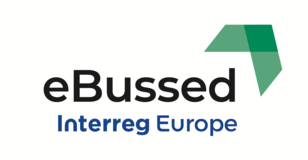The insightful two-day Utrecht good practice event combined practical knowledge, essential details, and interesting site visits to the public transport players in Utrecht.
Representatives and their stakeholders from the European regions participated in the eBussed good Practice event organized by the Province of Utrecht and HU University of Applied Sciences Utrecht at the end of March. This was the first on-site meeting in almost two years since the start of the e-Bussed project in 2019. The aim of the meeting was to bring stakeholders together and to share good Practices regarding electric buses. As one of the partners described after the event, the agenda was ambitious but the time flew by.
The Utrecht context and depot visits
The first day of the event was dominated by the Utrecht and Dutch experiences. Several experts explained the context of public transport in the Utrecht region and discussed examples such as monitoring e-bus performance, smart charging, training e-bus drivers, and zero-emission principles in the provincial policy.
In the transition to electric buses, there is no one-size-fits-all solution. Presentations from smart charging to urban planning showed that everything from energy infrastructure to cityscape and topography to driver and staff training needs to be taken into consideration in the e-bus deployment planning. Therefore, the event made it clear that sharing good practices is important for all regions that are aiming at electrification of their public transportation.
The participants were treated with a well-balanced programme of presentations and excursions. One afternoon was spent on an excursion on an e-bus. The participants visited an end-of-line charging facility, where the driver demonstrated the use of an opportunity charger. The visit also took us to two bus depots. The first one, Westraven, is being built for electric buses. To protect the area from battery fires, tall concrete walls were erected. In the future, the depot grid capacity makes it possible to charge up to 140 buses simultaneously. The second depot, Remiseweg, had an opportunity and plug-in chargers to charge all the transport company’s e-buses. The buses are charged during driver’s breaks and at night.
At the end of the day, the participants paid a visit to TRIBUS, a local e-bus manufacturer, sharing their visions of the future and technologies. The company’s electric midibus innovation, Movitas, is specially designed for the narrow streets of city centres and it will be piloted next year in Utrecht as part of the regional action plan that was developed in eBussed.
Action plans and the heart of the Dutch transport system
On day two, experts from the other project regions preseted selected good practices, giving the audience the possibility to ask questions and comment on them. During the project, the partners have learned from each other’s good practices and assessed whether they could apply them in their regions. The good practices and other lessons learned are transformed into regional Action Plans aiming to improve local policy instruments and thus enhancing the possibilities to deploy e-busses.
The party visited the heart of the Netherlands’ public transport system: the Central Station in Utrecht. It is the largest infrastructural node in the Netherlands, an impressive transit hub at the Utrecht Station linking public transport within the city and across the country. The presenter explained the history of the area and how, during the past 20 years, the aim has been to develop the area sustainably. This presentation tied together many topics discussed in the event, as it showed in practice that sustainable transport does not exist in a vacuum but needs to be developed together with other modes of transportation, urban planning, and visions of the future.
After the visit, everyone was sufficiently charged to discuss the most burning topic in an action plan workshop, giving a possibility to learn and comment on the action plan drafts. This turned out to be a fruitful approach and the development will now continue until the end of the project Phase 1.
Overall, the event was appreciated very much by the participant. Most frequently heard comments were: "How good it is to finally see and talk to each other!", "It is also very important to look at the spatial impact of all e-bus facilities." and "Good to see that each region is growing experienced in devising plans to introduce e-buses in the public transport on a large scale.”











